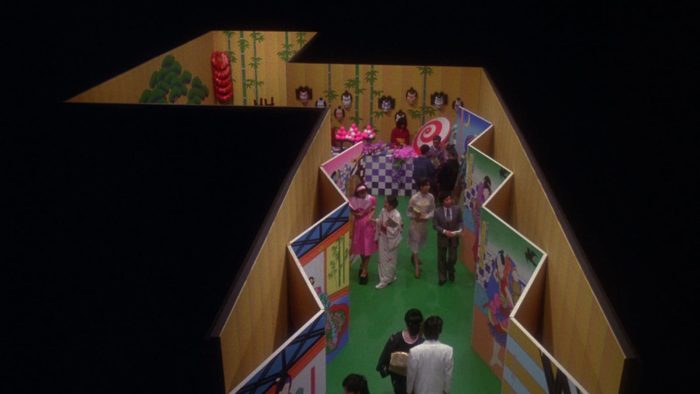
Despite only a limited knowledge of Paul Schrader’s filmography, I feel it’s safe to say that he is drawn to stories about loners making rash decisions. I think every movie I’ve seen that he’s written or directed has starred isolated characters who find themselves at odds with society. So it’s easy to imagine why Schrader would want to tell the story of Japanese author Yukio Mashima, who committed suicide after staging a failed coup d’etat fifteen years before this movie’s release. But it’s Schrader’s telling of the story that is so interesting, as it provides a template for why so many contemporary biopics seem like boring Oscar bait.
Mishima: A Life in Four Chapters begins in the typical biographical movie mold, with Mishima making preparations for his “little drama” on the last day of his life. Mishima is a handsome, powerfully built man who elegantly dresses himself in an old-fashioned military uniform he designed himself. He completes the look with an ancient samurai sword that he has a permit to carry. As Mishima meets four younger men, all wearing the same uniform, and they drive off into the city, the film flashes back to Mishima’s youth. Growing up, he was sickly and had trouble with his own conceptualization of masculinity, something he would wrestle with his entire life. Then the movie throws a curveball.
As you might have guessed from the title, this movie is divided into four chapters. Each of them deals with an important aspect of Mishima’s life, which the movie also links to one of Mishim’a novel. So the movie is as much an adaptation of those books as it is the author’s life. The first, Temple of the Golden Pavilion, is about a stuttering young man who has a terrible relationship with beauty. Kyoko’s House follows an actor who becomes involved in a doomed masochistic relationship with an older woman. Finally, in Runaway Horses, a gifted kendo student leads a group of young nationalists in an attempt to overthrow the government in 1932. Sound familiar?
The flashback scenes of Mishima’s life are shot in black and white, which is starkly contrasted by the scenes from the books, which are shot stylishly in color and performed on a sound stage. The fourth chapter does not adapt a novel, but does present the last day of Mishima’s life in color. I think the message is clear enough, the line between art and artist, as well as sanity and madness, ceased to exist in the end. In doing so, Schrader finds grace in the ridiculous and shows how Mishima’s end might have been, somehow, poetic… But still, dude was pretty nuts.
The thing with biopics is that they’re typically so relentlessly formulaic you can easily predict their main beats just be reading the subject’s Wikipedia page. Walk Hard: The Dewey Cox Story probably should have put an end to the entire genre. The main way I’ve seen movies get away from this problem is by taking artistic license with the story they’re trying to tell, getting us great movies like Amadeus which have, ultimately, a tenuous relationship with the truth.
Another problem with biopics, specifically movies about artists, is that it’s hard to make art about art. It’s even harder to convey why that art is important. So you get scenes with the band performing for a record producer who can’t believe what they’re hearing or the author’s girlfriend dramatically telling him that his latest manuscript is going to change the world. I get it, it’s a tough problem to solve. But that’s why I think Mishima is so novel.
The genius of adapting three books is that you never need to have a seen of people fawning over Mishima’s writing. The movie shows you what kind of a man he was, what kind of stories he told, what his values were. It accomplishes the platonic ideals of this genre without changing history or telling the audience what to make of him. And, in it’s most Schrader-ish touch, it reminders you that a crazy person doesn’t think that they’re crazy. Shine on you crazy diamond.


